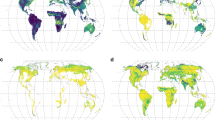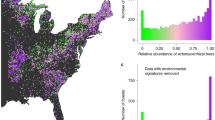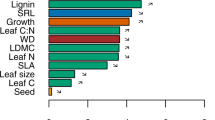Abstract
Forest ecosystems store ~80% of the carbon in terrestrial ecosystems, but their long-term carbon sequestration depends partly on how plant biomass and soil carbon stocks will respond to global changes. Although the stimulation of plant growth by global change drivers has been widely observed, the response of soil carbon stock to global changes remains uncertain. Here we conducted a meta-analysis on experimental observations of plant and soil carbon-related data worldwide. We found that plant biomass and soil carbon stock increased more under elevated CO2 than under nitrogen deposition and warming. Under nitrogen deposition and warming, soil carbon stock depended on mycorrhizal associations, decreasing in forests dominated by arbuscular mycorrhizal tree species while increasing in forests dominated by ectomycorrhizal tree species. These results suggest a mycorrhizae-mediated trade-off between plant biomass and soil carbon sequestration in forest ecosystems under nitrogen deposition and warming conditions.
This is a preview of subscription content, access via your institution
Access options
Access Nature and 54 other Nature Portfolio journals
Get Nature+, our best-value online-access subscription
$29.99 / 30 days
cancel any time
Subscribe to this journal
Receive 12 print issues and online access
$209.00 per year
only $17.42 per issue
Buy this article
- Purchase on Springer Link
- Instant access to full article PDF
Prices may be subject to local taxes which are calculated during checkout





Similar content being viewed by others
Data availability
All relevant data presented in this meta-analysis are available at Figshare (https://doi.org/10.6084/m9.figshare.23984409.v1)55.
Code availability
All code used can be obtained from Figshare (https://doi.org/10.6084/m9.figshare.23937600.v2)55.
References
Dixon, R. K. et al. Carbon pools and flux of global forest ecosystems. Science 263, 185–190 (1994).
Pan, Y. D. et al. A large and persistent carbon sink in the world’s forests. Science 333, 988–993 (2011).
Lal, R. Forest soils and carbon sequestration. For. Ecol. Manage 220, 242–258 (2005).
Terrer, C. et al. Mycorrhizal association as a primary control of the CO2 fertilization effect. Science 353, 72–74 (2016).
Schulte-Uebbing, L. & de Vries, W. Global-scale impacts of nitrogen deposition on tree carbon sequestration in tropical, temperate, and boreal forests: a meta-analysis. Glob. Change Biol. 24, e416–e431 (2017).
Lin, D. L., Xia, J. Y. & Wan, S. Q. Climate warming and biomass accumulation of terrestrial plants: a meta-analysis. N. Phytol. 188, 187–198 (2010).
Liu, L. L. & Greaver, T. L. A global perspective on belowground carbon dynamics under nitrogen enrichment. Ecol. Lett. 13, 819–828 (2010).
Crowther, T. W. et al. Quantifying global soil carbon losses in response to warming. Nature 540, 104–108 (2016).
Zhou, L. Y. et al. Different responses of soil respiration and its components to nitrogen addition among biomes: a meta-analysis. Glob. Change Biol. 20, 2332–2343 (2014).
Schlesinger, W. H. & Lichter, J. Limited carbon storage in soil and litter of experimental forest plots under increased atmospheric CO2. Nature 411, 466–469 (2001).
Melillo, J. M. et al. Long-term pattern and magnitude of soil carbon feedback to the climate system in a warming world. Science 358, 101–105 (2017).
Gundale, M. J. et al. Anthropogenic nitrogen deposition in boreal forests has a minor impact on the global carbon cycle. Glob. Change Biol. 20, 276–286 (2014).
Nadelhoffer, K. J. et al. Nitrogen deposition makes a minor contribution to carbon sequestration in temperate forests. Nature 398, 145–148 (1999).
Terrer, C. et al. A tradeoff between plant and soil carbon storage under elevated CO2. Nature 591, 599–603 (2021).
Ma, X. M. et al. Root and mycorrhizal strategies for nutrient acquisition in forests under nitrogen deposition: a meta-analysis. Soil Biol. Biochem. 163, 108418 (2021).
Jastrow, J. D. et al. Elevated atmospheric carbon dioxide increases soil carbon. Glob. Change Biol. 11, 2057–2064 (2005).
Soong, J. L. et al. Five years of whole-soil warming led to loss of subsoil carbon stocks and increased CO2 efflux. Sci. Adv. 7, eabd1343 (2021).
Cheng, L. et al. Arbuscular mycorrhizal fungi increase organic carbon decomposition under elevated CO2. Science 337, 1084–1087 (2012).
Pellitier, P. T. & Zak, D. R. Ectomycorrhizal fungi and the enzymatic liberation of nitrogen from soil organic matter: why evolutionary history matters. N. Phytol. 217, 68–73 (2018).
Phillips, R. P., Brzostek, E. & Midgley, M. G. The mycorrhizal‐associated nutrient economy: a new framework for predicting carbon nutrient couplings in temperate forests. N. Phytol. 222, 556–564 (2019).
Keller, A. B. & Phillips, R. P. Leaf litter decay rates differ between mycorrhizal groups in temperate, but not tropical, forests. N. Phytol. 199, 41–51 (2013).
Midgley, M. G., Brzostek, E. & Phillips, R. P. Decay rates of leaf litters from arbuscular mycorrhizal trees are more sensitive to soil effects than litters from ectomycorrhizal trees. J. Ecol. 103, 1454–1463 (2015).
Treseder, K. K. & Allen, M. F. Mycorrhizal fungi have a potential role in soil carbon storage under elevated CO2 and nitrogen deposition. N. Phytol. 147, 189–200 (2000).
van Groenigen, K. J. et al. Faster decomposition under increased atmospheric CO2 limits soil carbon storage. Science 344, 508–509 (2014).
Zhou, L. Y. et al. Global systematic review with meta-analysis shows that warming effects on terrestrial plant biomass allocation are influenced by precipitation and mycorrhizal association. Nat. Commun. 13, 4914 (2022).
Chen, J. et al. Differential responses of carbon-degrading enzyme activities to warming: implications for soil respiration. Glob. Change Biol. 24, 4816–4826 (2018).
Liang, X. Y. et al. Global response patterns of plant photosynthesis to nitrogen addition: a meta-analysis. Glob. Change Biol. 26, 3585–3600 (2020).
Peng, Y. F., Guo, D. L. & Yang, Y. H. Global patterns of root dynamics under nitrogen enrichment. Glob. Ecol. Biogeogr. 26, 102–114 (2017).
Li, W. B. et al. Effects of nitrogen enrichment on tree carbon allocation: a global synthesis. Glob. Ecol. Biogeogr. 29, 573–589 (2020).
Peng, Y. F. & Yang, Y. H. Allometric biomass partitioning under nitrogen enrichment: evidence from manipulative experiments around the world. Sci. Rep. 6, 28918 (2016).
Zhao, X. X. et al. Fine-root functional trait response to nitrogen decomposition across forest ecosystems: a meta-analysis. Sci. Total Environ. 844, 157111 (2022).
Lu, X. F. et al. Decrease in soil pH has greater effects than increase in aboveground carbon inputs on soil organic carbon in terrestrial ecosystems of China under nitrogen enrichment. J. Appl. Ecol. 59, 768–778 (2022).
Averill, C., Dietze, M. C. & Bhatnagar, J. M. Continental-scale nitrogen pollution is shifting forest mycorrhizal associations and soil carbon stocks. Glob. Change Biol. 24, 4544–4553 (2018).
Kjøller, R. et al. Dramatic changes in ectomycorrhizal community composition, root tip abundance and mycelial production along a stand-scale nitrogen deposition gradient. N. Phytol. 194, 278–286 (2012).
Carrara, J. E. et al. Differences in microbial community response to nitrogen fertilization result in unique enzyme shifts between arbuscular and ectomycorrhizal-dominated soils. Glob. Change Biol. 27, 2049–2060 (2021).
Deng, Q. et al. Responses of terrestrial ecosystem phosphorus cycling to nitrogen addition: a meta-analysis. Glob. Ecol. Biogeogr. 26, 713–728 (2017).
Högberg, P. et al. Tree growth and soil acidification in response to 30 years of experimental nitrogen loading on boreal forest. Glob. Change Biol. 12, 489–499 (2006).
Bae, K. et al. Soil nitrogen availability affects belowground carbon allocation and soil respiration in northern hardwood forests of New Hampshire. Ecosystems 18, 1179–1191 (2015).
Xing, A. J. et al. High-level nitrogen additions accelerate soil respiration reduction over time in a boreal forest. Ecol. Lett. 25, 1869–1878 (2022).
Sulman, B. N. et al. Microbe-driven turnover offsets mineral-mediated storage of soil carbon under elevated CO2. Nat. Clim. Change 4, 1099–1102 (2014).
Phillips, R. P., Finzi, A. C. & Bernhardt, E. S. Enhanced root exudation induces microbial feedbacks to N cycling in a pine forest under long-term CO2 fumigation. Ecol. Lett. 14, 187–194 (2011).
Pierson, D. et al. Mineral stabilization of soil carbon is suppressed by live roots, outweighing influences from litter quality or quantity. Biogeochemistry 154, 433–449 (2021).
Reich, P. B. & Hobbie, S. E. Decade-long soil nitrogen constraint on the CO2 fertilization of plant biomass. Nat. Clim. Change 3, 278–282 (2013).
Terrer, C. et al. Nitrogen and phosphorus constrain the CO2 fertilization of global plant biomass. Nat. Clim. Change 9, 684–689 (2019).
Mao, Z. K. et al. Tree mycorrhizal associations mediate soil fertility effects on forest community structure in a temperate forest. N. Phytol. 223, 475–486 (2019).
Luo, Y. Q. et al. Progressive nitrogen limitation of ecosystem responses to rising atmospheric carbon dioxide. BioScience 54, 731–739 (2004).
Song, J. et al. A meta-analysis of 1119 manipulative experiments on terrestrial carbon-cycling responses to global change. Nat. Ecol. Evol. 3, 1309–1320 (2019).
Bueno, C. G. et al. Plant mycorrhizal status, but not type, shifts with latitude and elevation in Europe. Glob. Ecol. Biogeogr. 26, 690–699 (2017).
Wang, B. & Qiu, Y. L. Phylogenetic distribution and evolution of mycorrhizas in land plants. Mycorrhiza 16, 299–363 (2006).
Brundrett, M. C. & Tedersoo, L. Evolutionary history of mycorrhizal symbioses and global host plant diversity. N. Phytol. 220, 1108–1115 (2018).
Viechtbauer, W. Conducting meta-analyses in R with the metafor package. J. Stat. Softw. 36, 185–190 (2010).
Jonathan, J. A. C. & Egger, M. Funnel plots for detecting bias in meta-analysis: guidelines on choice of axis. J. Clin. Epidemiol. 54, 1046–1055 (2001).
Egger, M. et al. Bias in meta-analysis detected by a simple, graphical test. Br. Med. J. 315, 629–634 (1997).
Duval, S. & Tweedie, R. A nonparametric ‘trim and fill’ method of accounting for publication bias in meta-analysis. J. Am. Stat. Assoc. 95, 89–98 (2000).
Yang, K. et al. Supporting data for ‘Mycorrhizal type regulates tradeoffs between plant and soil carbon in forests’. Figshare https://doi.org/10.6084/m9.figshare.23984409.v1 and https://doi.org/10.6084/m9.figshare.23937600.v2 (2023).
Acknowledgements
This study was financially supported by CAS Project for Young Scientists in Basic Research grant YSBR-037 (K.Y.), the National Natural Science Foundation of China grants 32192435 (J.Z.) and 31922059 (K.Y.), the National Key Research and Development Program of China grants 2020YFA0608103 (J.Z.) and 2022YFF1300500 (K.Y.).
Author information
Authors and Affiliations
Contributions
K.Y. and J.Z. designed the study. Q.Z. collected data. K.Y. and Q.Z. performed the meta-analysis. K.Y. wrote the article, with significant contributions provided by J.Z., G.G.W., Q.Z., Q.W. and T.G. All the authors contributed to the discussions and paper revision.
Corresponding author
Ethics declarations
Competing interests
The authors declare no competing interests.
Peer review
Peer review information
Nature Climate Change thanks Shuijin Hu and Ashley Lang for their contribution to the peer review of this work.
Additional information
Publisher’s note Springer Nature remains neutral with regard to jurisdictional claims in published maps and institutional affiliations.
Supplementary information
Supplementary Information
Supplementary Figs. 1–5, Tables 1–3 and database references.
Supplementary Table 1
The systematic review reports are a checklist of details that include type of review, authors’ contacts, the contents of manuscript and other items.
Supplementary Data 1
The database of carbon-related variables under nitrogen deposition, elevated CO2 and warming effects.
Rights and permissions
Springer Nature or its licensor (e.g. a society or other partner) holds exclusive rights to this article under a publishing agreement with the author(s) or other rightsholder(s); author self-archiving of the accepted manuscript version of this article is solely governed by the terms of such publishing agreement and applicable law.
About this article
Cite this article
Yang, K., Zhang, Q., Zhu, J. et al. Mycorrhizal type regulates trade-offs between plant and soil carbon in forests. Nat. Clim. Chang. 14, 91–97 (2024). https://doi.org/10.1038/s41558-023-01864-5
Received:
Accepted:
Published:
Issue Date:
DOI: https://doi.org/10.1038/s41558-023-01864-5



